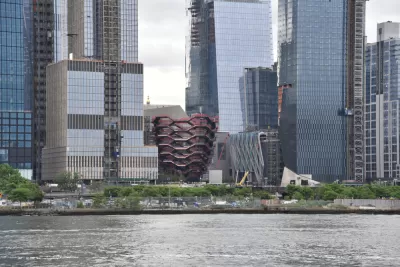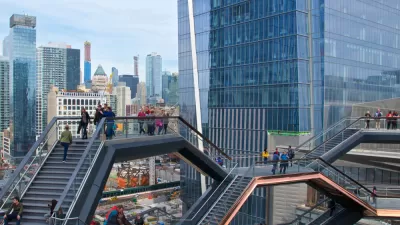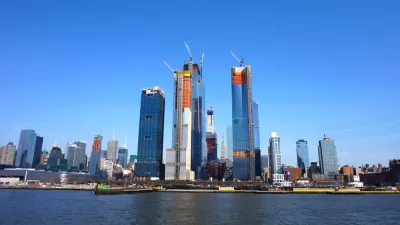Curbed Architecture Critic Alexandra Lange provides everything you need to know about the $25 billion, "city within the city" that opened to the public in Manhattan today. Also, the review isn't exactly positive.

Alexandra Lange reviews the Hudson Yards on the day of the mammoth development project's opening day in New York City.
The $25 billion project has been described as the largest private real estate development in U.S. history and a "future city." Lange is neither taken by those prospects, nor impressed with the attempt.
The problem of the design of Hudson Yards, the 28-acre, $25 billion development built on a platform over Penn Station’s working railroad tracks, is that there is no contrast. No weirdness, no wildness, nothing off book. The megaproject was built by an all-star team of designers, but in the end, it’s impossible to tell the difference between the corporate and the artistic.
Lange's review walks the reader through the development, with vantages offered from the High Line, specific towers in the project, like 55 Hudson Yards and 15 Hudson Yards ("maybe they need names?" asks Lange, rhetorically), and, of course, The Vessel.
Whatever you call Heatherwick Studio’s Vessel—the wastebasket, the egg-crate, the Escher-brought-to-life, the basketball net, the Great Doner Kebab—it is the opposite of those examples. Not temporary, not cuddly, not delicate. It looks just like its renderings except possibly more perfect. I had mentally assigned it an outer cladding of weathering steel; with everything else so smooth and shiny, surely Vessel would have an industrial flavor? But no—Heatherwick Studio leaned into the fractal nature of its design, and the cladding, copper-colored steel, has a mirror finish like Anish Kapoor’s Bean in Chicago’s Millennium Park, welcoming our irresistible impulse to selfie. As we assembled on the plaza below it, the underside of the upper tiers crisply reflected us as ants in bright orange safety vests.
Finally, there's the issue of Hudson Yards becoming the first "North American smart city." Here, Lange dispatches with the utopian dreams of techno-optimists:
Ultimately, though, does it matter? For all the talk of Hudson Yards as being the first North American smart city, it doesn’t feel like the future, except for perhaps the video screens that advertise, offer touchscreen wayfinding, ticketing, and—surprise!—enclose cameras that watch your every move. The majority of innovations called out on the press packet sheet labeled “Engineered City” are largely under the hood: A constant stream of inputs monitored by “operations managers” will allow Hudson Yards, the sentient being, “to monitor and react to traffic patterns, air quality, power demands, temperature and pedestrian flow to create the most efficiently navigated and environmentally attuned neighborhood in New York.”
The article has pretty much everything you could hope for from a design review of the largest private development in U.S. history—images, links, Twitter jokes, and even a William H. Whyte reference.
FULL STORY: At Hudson Yards, the future isn’t now

Americans May Be Stuck — But Why?
Americans are moving a lot less than they once did, and that is a problem. While Yoni Applebaum, in his highly-publicized article Stuck, gets the reasons badly wrong, it's still important to ask: why are we moving so much less than before?

Using Old Oil and Gas Wells for Green Energy Storage
Penn State researchers have found that repurposing abandoned oil and gas wells for geothermal-assisted compressed-air energy storage can boost efficiency, reduce environmental risks, and support clean energy and job transitions.

Placekeeping: Setting a New Precedent for City Planners
How a preservation-based approach to redevelopment and urban design can prevent displacement and honor legacy communities.

San Francisco’s Muni Ridership Grew in 2024
The system saw its highest ridership since before the Covid-19 pandemic, but faces a severe budget shortage in the coming year.

Colorado Lawmakers Move to Protect BRT Funding
In the face of potential federal funding cuts, CDOT leaders reasserted their commitment to planned bus rapid transit projects.

Safe Streets Funding in Jeopardy
The Trump administration is specifically targeting bike infrastructure and other road safety projects in its funding cuts.
Urban Design for Planners 1: Software Tools
This six-course series explores essential urban design concepts using open source software and equips planners with the tools they need to participate fully in the urban design process.
Planning for Universal Design
Learn the tools for implementing Universal Design in planning regulations.
Heyer Gruel & Associates PA
City of Moreno Valley
Institute for Housing and Urban Development Studies (IHS)
City of Grandview
Harvard GSD Executive Education
Salt Lake City
NYU Wagner Graduate School of Public Service
City of Cambridge, Maryland




























